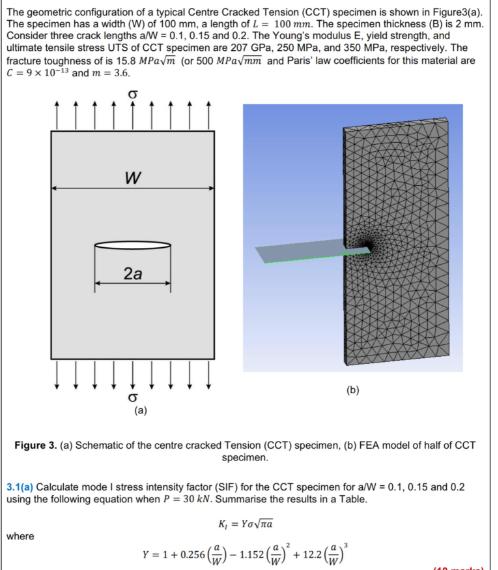Answered step by step
Verified Expert Solution
Question
1 Approved Answer
The geometric configuration of a typical Centre Cracked Tension (CCT) specimen is shown in Figure3(a). The specimen has a width (W) of 100 mm,

The geometric configuration of a typical Centre Cracked Tension (CCT) specimen is shown in Figure3(a). The specimen has a width (W) of 100 mm, a length of L= 100 mm. The specimen thickness (B) is 2 mm. Consider three crack lengths a/W = 0.1, 0.15 and 0.2. The Young's modulus E, yield strength, and ultimate tensile stress UTS of CCT specimen are 207 GPa, 250 MPa, and 350 MPa, respectively. The fracture toughness of is 15.8 MPaym (or 500 MPamm and Paris' law coefficients for this material are |C=9x 10-13 and m = 3.6. W 2a where O (b) Figure 3. (a) Schematic of the centre cracked Tension (CCT) specimen, (b) FEA model of half of CCT specimen. 3.1(a) Calculate mode I stress intensity factor (SIF) for the CCT specimen for a/W = 0.1, 0.15 and 0.2 using the following equation when P = 30 kN. Summarise the results in a Table. K = Yona Y = 1 +0.256 ()-1.152 (+ 122 (
Step by Step Solution
★★★★★
3.40 Rating (147 Votes )
There are 3 Steps involved in it
Step: 1
To calculate the mode I stress intensity factor SIF for the CCT specimen for crack lengths aW 01 015 ...
Get Instant Access to Expert-Tailored Solutions
See step-by-step solutions with expert insights and AI powered tools for academic success
Step: 2

Step: 3

Ace Your Homework with AI
Get the answers you need in no time with our AI-driven, step-by-step assistance
Get Started


